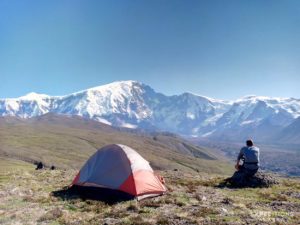Backpacking Gear & Food Info
-
How do I manage my cell phone battery in the backcountry?
Carefully. But here are a few tips.
- You DEFINITELY want to ensure your phone is fully charged before you hop on the float plane.
- Make sure you turn Airplane mode on, so it’s not looking for signal.
- Switch to low power mode (if it’s an iPhone)
- Dim the screen a bit
- You can also buy a small battery pack. I use a small one by GoalZero.
And AGAIN, TURN IT ON AIRPLANE MODE.
-
What gear do I need?
You’ll receive a Trip Departure Packet upon your reservation with a detailed Gear section and a comprehensive Gear Check List for you. Read it carefully and be sure you have the appropriate gear with you. We’ll do a gear review before your trip but you really should contact me with any questions you have before you arrive in AK.
You’ll find tons of information on gear and related stuff on the blog. You’ll find some extensive commentary there about gear and backpacking and hiking trips, etc. Rain gear and keeping dry, down versus synthetic sleeping bags , backpacks, and so forth. I update it reasonably often, so do check out the blog posts for information. Here is a link to The Gear Category on the blog.
In the meantime this should help you get started below.
Bring a sturdy backpacking tent. Lesser ‘car camping’ tents can fail miserably when you need them the most. If you don’t have a tent, or aren’t certain, please inquire with Expeditions Alaska. We’ll rent you a tent if you prefer.
Good rain gear is a must. I recommend a lightweight, gore-tex type shell. A poncho-style rain jacket or shawl is NOT recommended (as in, DO NOT BRING ONE).
A sleeping bag that will keep you warm down to 20deg (F) is what I suggest (or lower). A 32deg (F) bag would be considered bare minimum for most Alaskan summer adventures and I do NOT recommend it. Either synthetic fill bags or down bags are great – you just need to keep them dry. Read more about your sleeping bag here.
Unless you’re booking a fully outfitted trip you’ll need to bring a reliable stove. Bring a reliable stove, preferably one that burns white gas, or Coleman fuel. MSR ‘Whisperlite‘ or similar stoves are great. Remember that with current restrictions on air travel it is illegal to bring fuel onto commercial planes. I can provide fuel for you, available when you arrive in Alaska.
Another stove that’s very popular recently is the Jetboil.
My preference is for long sleeve shirts and full length brushed nylon pants. A mosquito headnet is also recommended for those times when the bugs get gnarly.
Do bring cotton pants, shirt, socks, etc. If you’re confused about this, contact me.
Trekking poles are worth their weight in gold. Don’t head for Alaska without them. Expeditions Alaskan provide these (free) if you like.
Definitely bring sturdy, waterproof boots. Your lightweight day hikers may be fine around town but they are often not durable enough to withstand a multi-day alpine adventure. Alaska Hiking boots info.
A comfortable backpack is required and a system for carrying gear on a dayhike is very handy. Many backpacks have removable tops and these work great. A rain cover that fits your fully loaded pack is a must have!
Another choice for is a small summit pack for dayhikes. I use the Marmot Kompressor. Not requisite but handy to have.
The single most important element of gear is your ability to use it.
Practice with your equipment before heading into the backcountry. Do not wait until you’re miles into the wilderness before you realize your stove doesn’t work or that you don’t know how to set up your tent. Being comfortable with your equipment and how to use it can be paramount to a safe and enjoyable trip.
-
Backpacking Gear Check List
Here’s a very simple gear check list. Email me if you have any specific gear/food questions. Try not to overpack but don’t short change yourself on essential items like raingear, tent, backpack, boots, sleeping bag, etc. Temperatures can be below freezing with rainy and even snowy weather.
Once we leave Anchorage (or Fairbanks), there are usually NO options for purchasing gear, supplies, food, etc. Anchorage has a great REI and several other gear stores, groceries, etc. The best option is to bring as much as you can with and only use Anchorage for forgotten and last minute items.
Expeditions Alaska will supply bear resistant food canisters, fuel (white gas/coleman fuel, or isobutane mix) and water filter system, First Aid Kit and maps. I highly recommend bringing your own “boo boo kit” – a basic first aid supplies, like sunscreen, blister kit, bandaids, ibuprofen/aleve, etc). We can, if you need, provide tents and food as well. Let me know if you have any specific gear requirements. We’re always glad to work to accommodate them.
I also recommend you see this post for my gear list for more information.
Food
Tent, w/ groundcloth
Sleeping Bag (20degF min)
Backpack – w/ rain cover
Trekking poles – (Provided if necessary, highly recommended*)
Sleeping pad
Lighter/matches
Plastic garbage bags
Eating utensils
bowl, mug
Water bottlesStove (check with Carl)
Cook set (check with Carl)
Fuel bottle (check with Carl)
A couple of gallon sized zip lock bags
Flashlight/headlamp (if before mid-Aug)
CompassLong underwear (wicking, top & bottom)
Long sleeve nylon shirt
Nylon Pants
Fleece Jacket
Additional thermal layer
Rain shell – Pants and Jacket
Wool or fleece gloves
Hat – Cap and 1 Fleece
Wool socks & liners
Backpacking Boots
Stuff Sacks
Sandals/Camp Shoes
Head Net/mosquito Repellent
Toiletry items – Toothbrush, toothpaste, Floss,
Toilet paper
Biodegradable soap, etcBlister stuff (mole foam second skin, etc)
Ibuprofen tablets
Bandaids
Sunscreen
Sunglasses
Lip balmSmall bath towel (2′ long)
Book/Reading material
Camera & Film/memory cards
Brush/comb20˚F, or lower, sleeping bag
Waterproof-breathable rain jacket and pants
Pack rain cover
Fleece jacket (min. 200 wt) or (even better) down/synthetic fill jacket
Sleeping pad
Poncho
Trash bag as rain gear or pack cover
Flip flops for river shoes
35˚F or higher rated sleeping bag -
How big does my backpack need to be?
Way too subjective to be a simple FAQ here. In the interest of keeping this simple, 65L is a good backpack for most of our trips (5-10 days). Anything smaller and you need to have your gear system dialed.
Is it doable to do a 10 day backpacking trip with a 45L backpack? Yes. Does it typically work well? Not at all.
For a more thorough discussion of appropriate backpack size, see this blog post.
-
What’s A Fully Outfitted Trip Involve?
That is trip dependent.
For backpacking trips, a fully outfitted option includes your tent (one or two person tent), all your kitchenware, food and cooking by Expeditions Alaska. A typical trip, up to 12 days long, costs an additional $450.00 per person for the fully outfitted option ($350 for 4 day trips or shorter).
Available “á la carte” options are (per person)
Tent $50.00/tent
Food/cooking $325.00 (up to 4 day trip duration)
Food/cooking $425 (any trip 5 days or longer)For personal items such as a backpack, or sleeping pad, talk to me prior to your trip and we’ll see if we can possibly arrange something. If you need a pack I recommend you rent a backpack from a reputable local outfitter. They can find and fit a pack to you rather than “making do” with one of mine that may or may not be a good fit for you.
Items such as BRFC, bear spray, fuel, hiking poles are included gratis with Expeditions Alaska trips. See What’s Included? for more info.
-
Can we book a basecamp trip if we don’t own any camping gear?
You sure can.
Fully outfitting your trip is a small additional fee. The exact amount will depend on your trip length, as well as what stuff you need.
For single individual items, contact me and we’ll see what you need and work that out.
A tent (1, 2 or 3 person) is $50.00 per person for the trip. If you just want us to handle food and you have all your own gear (tent, etc) we can do that as well.
Longer trips (5+ days) the food costs go up. But most basecamps are not longer.
We do provide sleeping bags or sleeping pads or backpacks (except for the scheduled photo tours we include sleeping pad).
-
What food do we bring?
Expeditions Alaska offer all guests the option of either providing your own food OR having us provide food for you. The prices posted on our site here do NOT include the additional cost incurred if you would like us to outfit the food for you.
“Goat Trail 15 -23 Aug 2016. Amazing experience. The entire experience was a pleasure. Thanks Carl and thanks for putting us with Rhane. He is an awesome guide and great cook. By the time we were finished, the group felt like we had made a new friend and the experience in the wilderness was life changing. The entire experience with Expeditions Alaska exceeded all my expectations. I am already looking at your website for my next Alaskan adventure. Cheers, GK”
If you would like to bring your own food, here’s a suggestion for novice hikers and those who are inexperienced with backcountry meal preparation. Typically, freeze-dried dinners work well for the inexperienced outdoor chef or those looking for an easier route. Some of the organically grown items, from smaller companies, aren’t bad at all. Mary Jane’s Farm has some great options for starters. They’re fast, easy, lightweight, packable, and require very little cleanup. Try different ones before you pack for your trip.
Less time preparing food allows for more time to enjoy the magnificent surroundings. They don’t taste too bad either!
For lunches I recommend items that don’t need to be cooked. Bagels, pita breads, nuts, dried fruit, candy bars, crackers, etc are great. Something hot for breakfast is a good start to the day, particularly if the weather is cold. Hot drinks such as hot cocoa, tea, or coffee can be very welcome at either end of the day.
If you want me to take care of your food, just let us know. We’re glad to put together a great menu, tailored to your tastes. Good food at the end of a hard day hiking definitely makes a difference!
-
Providing your own food – MXY trips
If you’re providing your own food for the trip you need to understand how many meals you might expect to bring.
For McCarthy based trips you won’t eat any meals in the backcountry until lunchtime on Day 2.
A trip billed as a 12 day trip, for example, would require you to pack 10 days worth of food plus extra food in case weather delays our pickup. It’s always wise to allow an extra day of food. All Expeditions Alaska trips to McCarthy, Wrangell-St. Elias National Park, unless specifically scheduled otherwise, will include a day travel to get to McCarthy, a day to return to Anchorage, and we fly out of the backcountry usually in the morning of the 2nd last day.
So for a trip scheduled, for example, Aug 1-12, you’ll need in your backpack
lunch and dinner on Aug 2
breakfast, lunch and dinner Aug 3-10
breakfast and maybe lunch of Aug 11
So I would suggest at least 10 full days food for your backpack.
-
What comes with the Food Add-on?
If you’d like, Expeditions Alaska can handle your backcountry food for the trip. Cost depends on trip length, but it’s typically $325 for a 2-4 day trip, and $425 for a trip 5 days or longer (backcountry days).
We will organize and pack the food, handle all backcountry prep, as well as pots and pans, the stove/s, fuel and your mess kit. Assistance for cleanup and dishes is always appreciated, but not requisite.
NB: this means, if we’re doing food for your trip, you must arrive with requisite space in your backpack for your share of the food. This typically means a BV500, sized 8.7 in. diameter. (22.1cm) x 12.7 in. (32.3cm) height. There’ll also be your mess kit (cup, bowl, cutlery, etc) and maybe some additional group gear, whether it’s a fuel bottle, stove or pan or skillet. In general your guide will carry the bulk of this stuff, but we certainly can’t and don’t intend to carry all of it. So don’t arrive with a backpack packed full, no space left in it, if we’re doing your food for you. Your food goes in your pack.
More info linked on the page below.
All your questions about our backcountry food answered right here.
-
What kind of menu do we get with the food purchase?
Trip dependent. For a 12 day backpack and packraft you can expect a different constitution of food than you’ll see on a 5 day basecamp trip.
Another thing to remember is Expeditions Alaska isn’t a simple “production line” outfit. Guides all have their own systems and menus and favorites, so we don’t have a generic “here’s your trip menu” at all. Menus vary trip to trip. Often a lot.
What I can tell you is you’ll enjoy good food. Really good food. Whether it’s a great pizza, a dish of Pad Thai or greek salad or a lentil soup, I assure you that you’ll appreciate your guides’ culinary expertise. Good food takes a bit extra effort, but can really help bring your trip experience up a notch. Or three.
We do our best to accommodate most dietary requirements, tastes and preferences. We have a comprehensive food form for you to complete and we’ll do our very best from there to put together a menu for the trip that you’ll enjoy.
This is a common question we get , and an important one. So important, it warrants its own page.
All your questions about our backcountry food answered right here.
Backpacking Gear Posts on the Blog
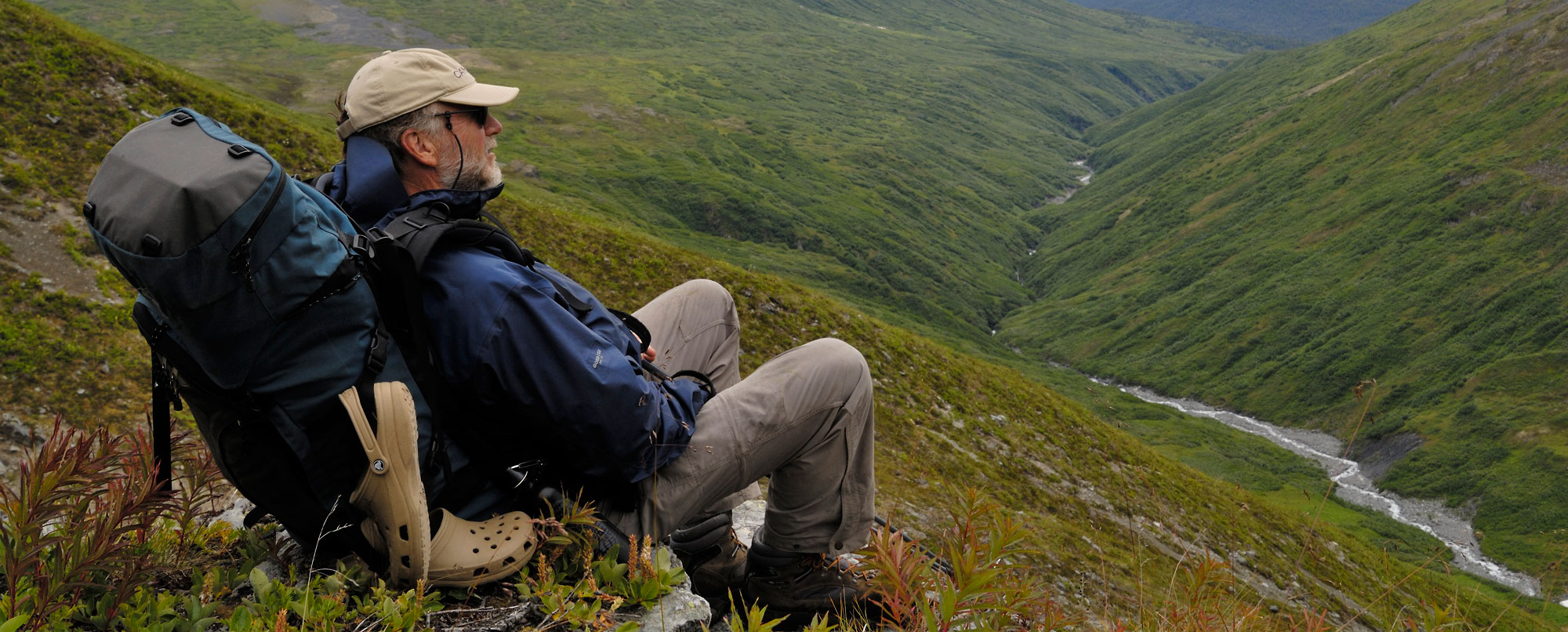
Hey Folks Backpacks are, of course, an integral piece of gear for a backpacking trip. What kind of backpack works best for you is not for me to say (see, for example, this post about what size backpack you need), but I can give you some information that might help you. I like internal frame […]
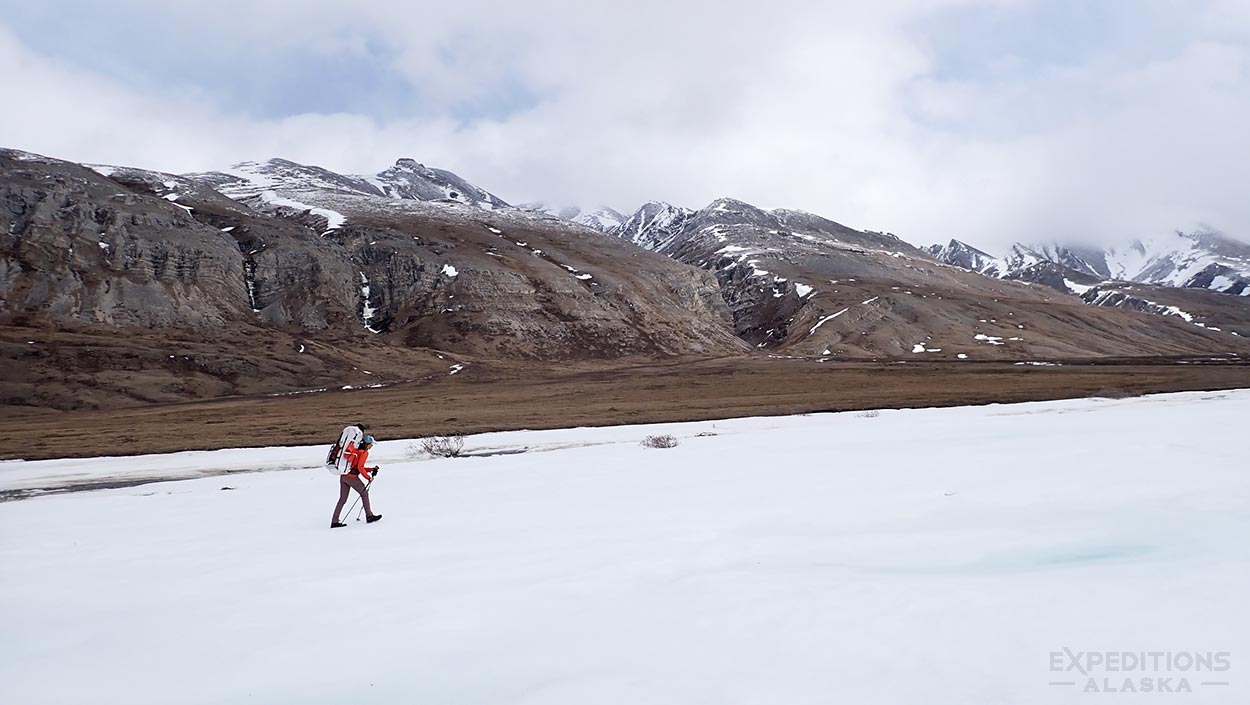
Questions about backpacks? Answers are here. We’ll start with how big it is. Size matters.
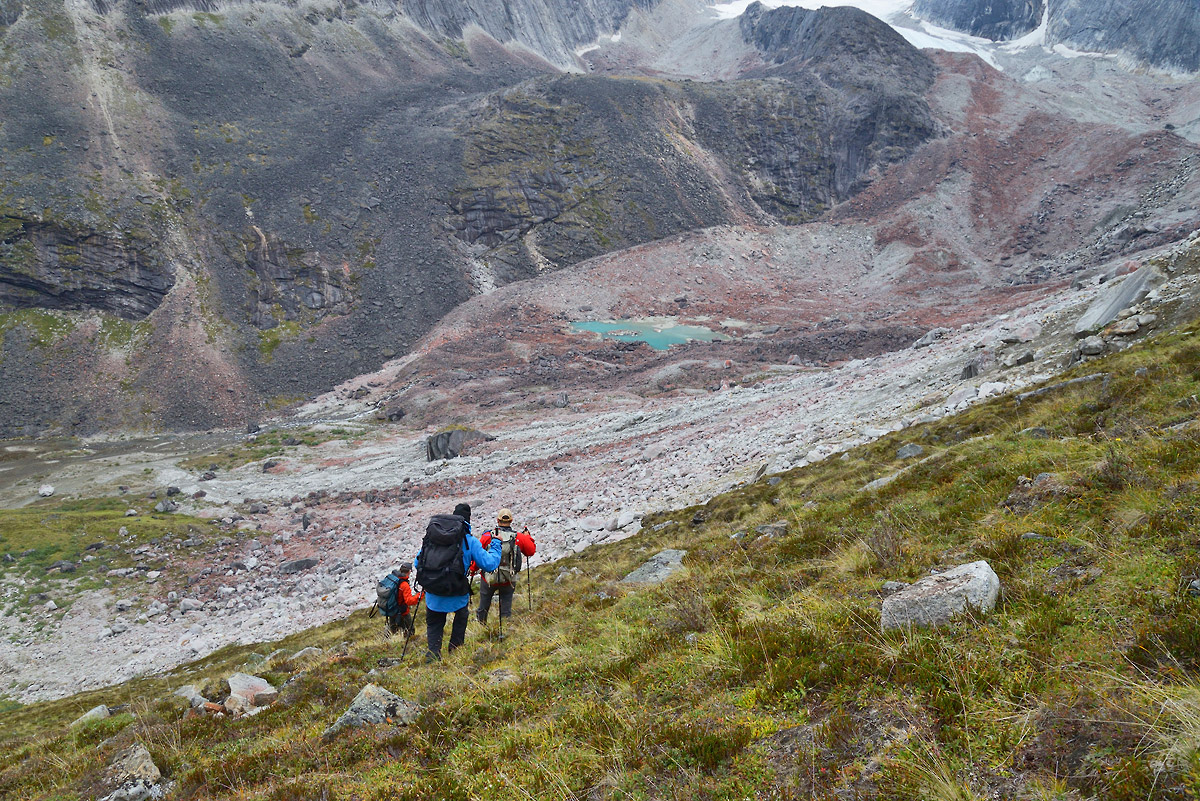
Hey Folks, I’ve written on the topic of trekking poles a few times in the past. Here also. Every year I receive a lot of questions about the use of trekking poles in Alaska. Nothing’s changed. Use them. The image above illustrates how useful they can be. Backpacking up or down steep terrain like this, often on […]

Hey Folks I get asked all the time which kind insulation fill is best for a sleeping bag for someone planing an Alaska backpacking trip. Like almost all these kinds of questions (such as what size backpack you need), the answer is pretty subjective, and I really don’t think it matters too much. What matters […]

Hiking and backpacking boots in Alaska A backpacking blog with no post about hiking boots? What gives? Hiking boots are one of those subjects that are SO subjective that it’s invariably a much lengthier conversation than a blog post might, or should, be. Different boots fit different people well, and different boots fit different situations […]
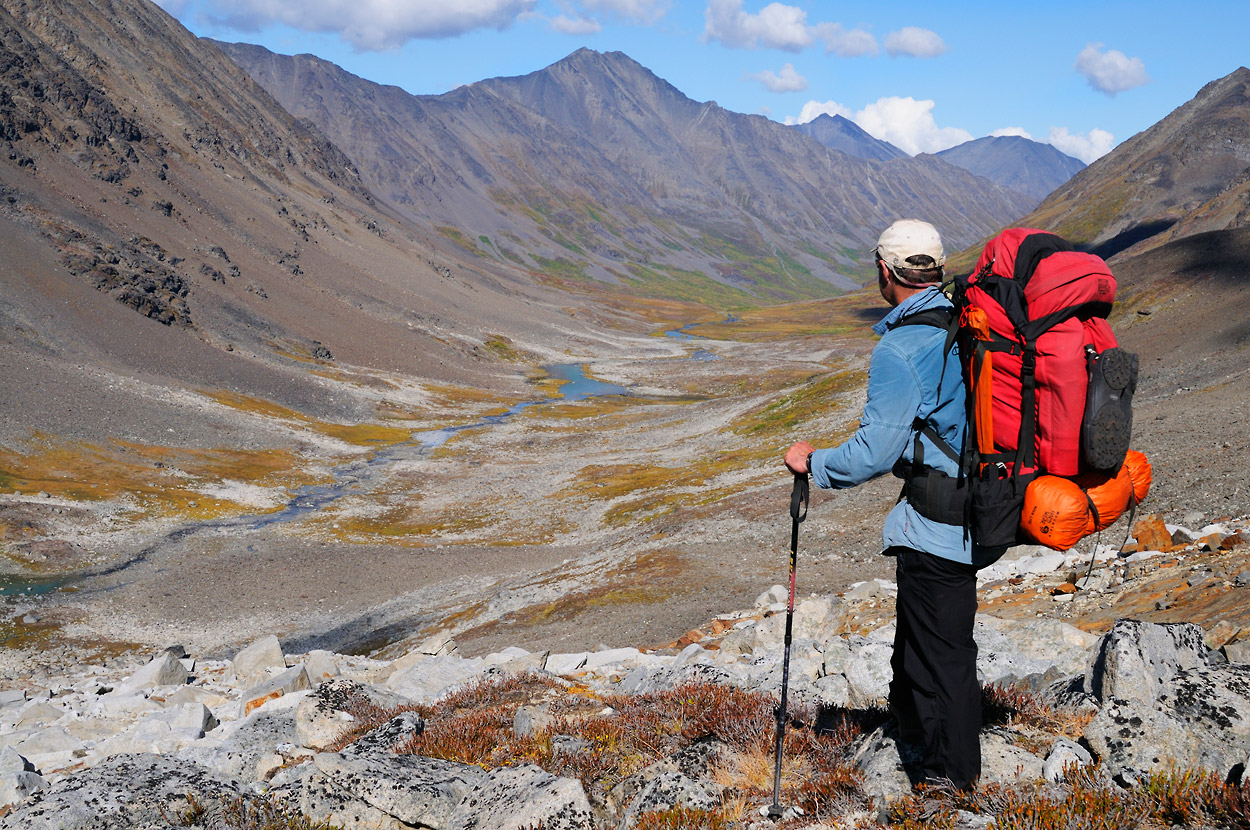
Benefits of hiking poles for hikers supported by a Scientific Study at Northumbria University.

Hey folks, I thought I’d write a quick post about insulation for hiking. This year, I made the switch from a pile fleece jacket to a synthetic fill jacket. The jacket that I virtually lived in all backpacking season long, (on plenty of day hikes as well, including this walk up to Powerline Pass near […]
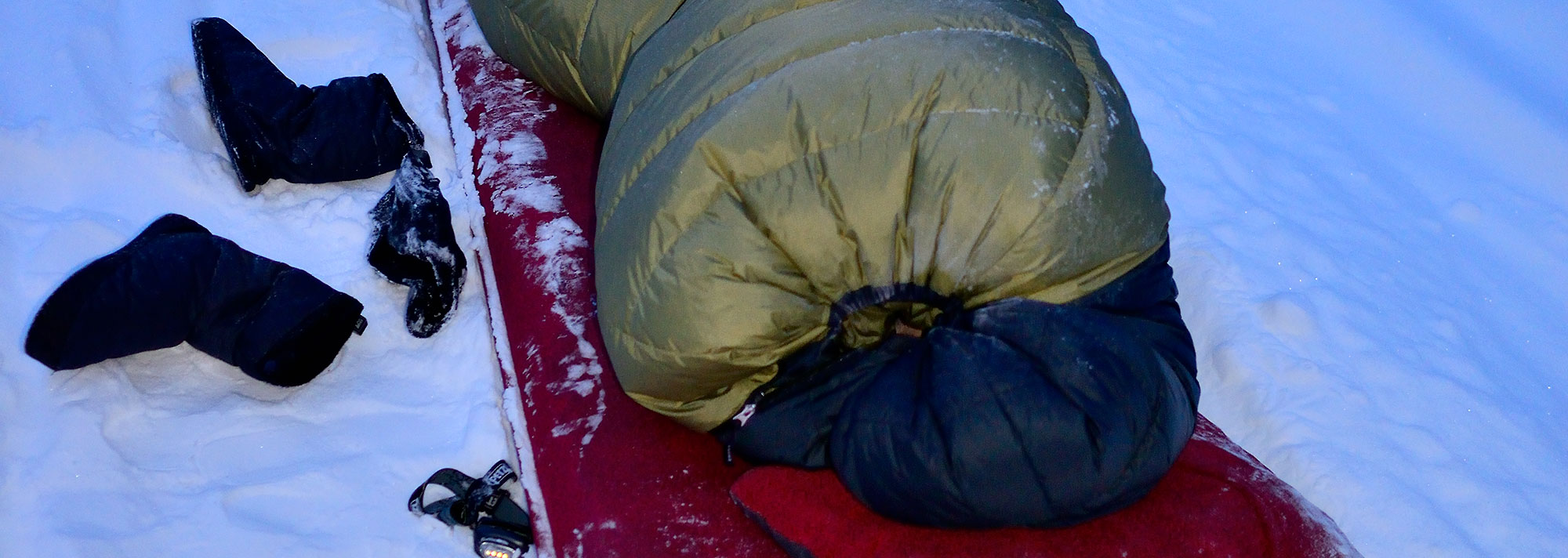
Sleeping bag rating for a trip to Alaska. Bring a 20deg bag. A snowy campsite on the high alpine tundra of Wrangell-St. Elias National Park. Termination dust covers the ground, or fresh fall snow, and Mt Jarvis (13 421′) of the Wrangell Mountains stands dominating behind. Backcountry campsite, Wrangell-St. Elias National Park and Preserve, Alaska.

Hey Folks, Welcome to the beginning of a lot of chatter about backpacking gear. The first thread is about tents. Specifically, MY tent, the Mountain Hardwear Skyledge 2. I can’t recommend this tent highly enough. 1 – it’s reasonably light. Any 2 person tent that comes to close to 4lbs is light, IMO. 2 – […]

Hey Folks Another question I get asked a lot has to do with rain gear. What’s appropriate, what’s necessary, what’s not OK, what works, what doesn’t, etc. I think rain gear is another of those things where many people can make do with less. I wouldn’t, of course, advise anyone to venture out under-prepared. But, […]

Hey Folks, I think a 20deg bag is essential for a summer trip in Alaska. 32deg bags, and warmer, often aren’t warm enough for alpine trips here. In fact, a 15 deg bag is even a good idea. it varies a lot with the individual, and also with the temperatures for any given trip, obviously. […]
Backpacking Trip Planning
-
What’s the best time of year to visit Alaska?
There is no one best time.
The backpacking season is short this far north and the season changes very quickly. Similarly there is a very large variance of conditions depending on where you go. A trip to the Kenai peninsula in September is very different to Gates of the Arctic NP at the same time. Alaska is wonderful late August/early September, the tundra colors blaze with orange, golds, reds and every imaginable variation of these.
Typically there are fewer bugs later in the year, with late May, June and early July the worst. May/June brings forth cute baby critters, blooming wildflowers, and the vibrancy of spring. It’s largely a matter of deciding what works best for you, what you want to see, and how best to accommodate that.
Snow can fall at any time in of the year, and weather is completely unpredictable. The days are longest during the latter weeks of June and first part of July, but those long glorious evenings last all the way up to late August.
-
Where will we be?
Alaska is a huge state. More than twice the size of Texas and approximately 1/3 the size of the lower 48 states.
Our adventures are primarily to Alaska’s interior, along the Canadian border in Wrangell – St.. Elias NP, northern Alaska in the Brooks Range, the Arctic National Wildlife Refuge (known as ANWR) in the far north, and the mountain ranges of the Kenai peninsula. Our Arrigetch Peaks trips visits Gates of the Arctic NP also. Contact Carl for specific information.
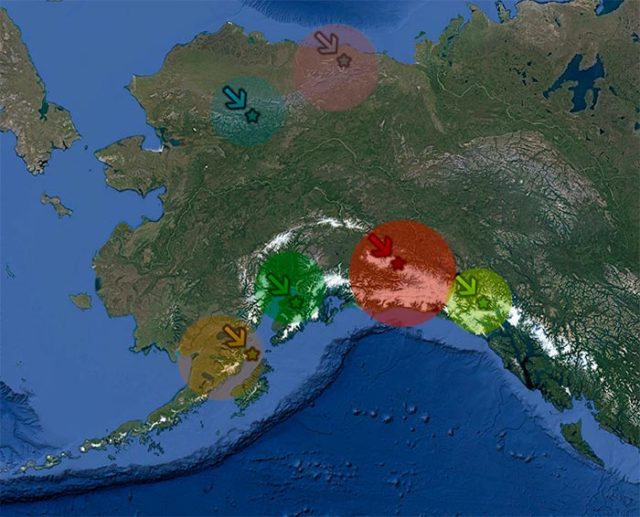
Mauve – Arctic National Wildlife Refuge
Blue – Gates of the Arctic National Park
Orange – Katmai National Park
Green – Anchorage/Kenai Peninsula
Red – Wrangell-St. Elias National Park
Light green – Southeast AlaskaThe map above shows a quick look at the various places on a map, or visit the “About Alaska” page for interactive google maps. I’ve also added a google earth link on most of the trip pages that will give you an idea of which part of the state a trip is in.
For now I am continuing to focus on Wrangell St. Elias National Park for a photography book I’m working on so many trips will be in that park.
-
How are the difficulty ratings defined?
Well, “defined” probably isn’t the right word. This is Alaska after all. But this an important question to consider.
One boot equals easiest and five boots the most challenging option. Thanks.
As a general rule I’d suggest rating everything here one notch from what you might be used to (assuming you haven’t hiked in Alaska before). If you consider yourself up for an intermediate level hike assume that a trip rated intermediate here will probably be a bit tougher than you’re expecting. Not impossible, but harder than you think.
As I mentioned above, terrain is the biggest factor here and it’s extremely subjective as to what is difficult terrain and what is not.
Some people really struggle walking over a boulder field, and others don’t find it difficult at all. Some people find sidehilling more difficult, or bushwhacking, and so on. Well, everybody finds sidehilling difficult. But the most common element people struggle with is almost always terrain. Your balance is probably a more important consideration than how miles you run on a treadmill each day in the gym.
One of the best ways to lower a rating is simply give yourself an extra day or 2. Make a 5 day hike a 7 day hike and it’ll much more manageable. Conversely, if you want a challenge give yourself a little less time and you’ll find just about any trip here as challenging as you could want it to be.
Again: please carefully . It’s the boot icon in the sidebar of the trip page.
Thanks.
-
Tell me about this “off trail” backpacking?
Typically, it doesn’t mean we go “off the trail“. It means there is trail. These are two very different things.
Offtrail hiking, or no trail hiking, is hard at times, easy at others, and very hard at others. It’s almost always changing, and not something you should dismiss as irrelevant. In fact, it’s probably the single most important thing to understand about our backpacking trips.
I’ll say that again. Louder.
When we say offtrail backpacking we’re talking about traversing boulder fields, hiking through dense brush, over steep scree and talus slopes and walking for hours on steep grassy mountainsides. All of which are harder than you think they are.
Trust me.
I’ll keep this post brief, but you can read a lot more about this subject (and I recommend that you do) on this blog post.
It’s important.
-
Do I need mountaineering skills?
No.
We guide trips that involve only trekking though some may be strenuous. The majority of these trips in Alaska are off-trail and at times involve hiking over moraines (boulder fields), scree slopes, across rivers, and tundra. None of this is easy.
If you’re a beginning backpacker, worry not. Trips are available for you, such as the Steamboat Hills walk in Wrangell St. Elias National Park which are better suited with easier walking, camping sites and less strenuous traverses.
-
How much experience do I need?
I work with all levels of backpackers from the novice to the experienced trekker.
In planning trips you should be as honest as possible about your experience and confidence so trips can be organized accordingly.
If you’ve never carried a backpack before or camped in the wilderness, it takes longer to get used to than you think. However we can accommodate your experience by scheduling a trip that works best for you.
Basecamping and dayhiking is a great way to really explore an area and means less time spent carrying the weight of a full pack. Conversely those more experienced may wish to plan a trip that covers more miles, and crosses more difficult terrains, the exploratory trips are great for experienced hikers.
Regardless of your situation, the more preparation you put into your trip the more rewarding it will be.
-
These trips really don’t seem that far?
In Alaska, as with most off-trail hiking, route mileages are deceptive and often somewhat useless information. People often have a tough time hiking here simply because they don’t understand different it can be.
A 30 mile route may sound like a nice 4 day walk but in reality 30 miles of off-trail Alaska backpacking is probably a 6 day walk for most hikers.
Hiking off-trail often involves moraine and scree slopes, steep sidehill traverse, route finding and bushwhacking, stream and river crossings, etc. Suffice it to say that maintaining an average speed of 3 miles per hour is pretty tough going here for any real length of time. A 5-7 mile day will in most likely be a tough day for most hikers.
Most people think in terms of distance and elevation gain/loss, and that’s really not typically the main factor here in Alaska. The type of terrain you’re hiking on is typically the biggest factor. And that terrain can change drastically in a short distance. You might get an easy mile of walking over open, rolling tundra, then hit a glacial moraine and that WILL slow you down.
So don’t think of these trips in terms of the mileage. At best it’s an estimate and more often than not completely irrelevant information. I put it on the website only because it’s what many people want to know. It’s gives a rough ballpark about a hike but it’s really NOT a sound gauge of what a trip entails.
-
How many days do we need for each trip?
This is the million dollar question!
Start with travel logistics.
Remember Expeditions Alaska handle most of your transport inside Alaska. That means we have 2 days travel time outside of your backcountry days. So a trip on the calendar for 8 days includes a day to travel from Anchorage to McCarthy, for example, and a day at the end of the trip for travel back to Anchorage. So we fly in to the backcountry and have 6 days. They are a few exceptions so read the logistics section of each trip page carefully.
Backpacking Trip Example
So how many days does it take to hike the Goat Trail, Skolai to Wolverine? Anywhere from 2 to 10, depending on your experience, interest, fitness, group size, and a host of other factors. Off trail travel means we’re not as concerned about a direct route from A to B, but are open to exploring all the side valleys and ridges and options along the way.
The routes are scheduled here based on what my experience shows me work best for the average backpacker. If you would like to hike the Seven Pass Route in 4 days, talk to me about it. Most folks like that trip over 6-8 days. Some might enjoy 10 days, There’s always plenty to see and do along the way so it really depends on how you would like to travel.
-
What about all the hazards?
A great trip is a safe one, and we take every precaution to ensure that you’re fully informed of how best to traverse the terrains, as well how to deal with any potential wildlife encounters.
Seeing a moose or grizzly bear in the wild is an exhilarating experience. Knowing how to avoid surprising the animals, or attracting their attention is key to avoiding conflicts.
Crossing rivers, scree slopes and glaciers are all potentially dangerous, and our experience and knowledge with the terrain is indispensable when traversing these regions. See more off-trail backpacking notes here.
-
How should I structure my travel arrangements?
Travel Suggestions
- Do NOT book your commercial flight early the next morning. The later the better. Better still, the day after that,
- Book a refundable/changeable ticket for your return flight home, and
- Purchase travel insurance.
Weather delays are always possible in the backcountry with bush planes.The more cushion you give yourself before a committed departure flight home, the better.Definitely don’t try to book something out on the evening of our return. Or the next morning. We SHOULD be back by then, but there are so many moving pieces to these trips, it’s much better to not have the stress of having to re-arrange flight schedules. Even if it’s just for something simple like road construction delays or flat tires, or a healthy travel schedule is one with some slack built into it.
Policy Stuff
-
COVID Policy and Protocols
As of 2023, we have reverted to pre-covid policy as usual. Below was our info during COVID.
As you well know, this is a difficult thing to navigate, but so far, knock on wood, we’ve been fortunate to not have any real issues.
It’s also difficult to lean too hard into any one approach to managing since the entire situation is in such a constant state of flux. Being as flexible as we can with what we need to do is critical.
Here is our COVID 2021 policy page, and we will update for 2022 as beyond as things unfold. Thanks.
-
Itinerary caveats
I put trip itineraries online here to give visitors a more detailed look at some of our trips and what options they include.
I can’t over-emphasize that each is simply an example.
What I work hardest on is tailoring trips to the specific interests and abilities and experience of the people who hike with us. No 2 trips are the same. Where possible we don’t use the same campsites when we do a route and we often even vary the route when appropriate to do so.
I try to be flexible with how far we hike each day and how many days we spend in the backcountry. What time we get up in the morning, for example, is largely up to the trip participants (unless for some reason I feel we need to be up and on the trail by a particular time – this rarely happens).
Itineraries are somewhat fluid. As they should be. Weather, hiker experience and many other factors determine the actual trip.
So don’t expect the itinerary for a trip to match an outline of Day 1 we hike abc, Day 2 we hike xyz, etc, etc. It doesn’t (and in my opinion shouldn’t) work that way. The itineraries listed on this site are
a) to outline the travel time and logistics for you, and
b) attempt to help give you some sense of the route and how it goes.
But with wilderness trail-less backpacking routes, these kinds of structured itineraries are really not very useful.
-
What’s the maximum size group we can take?
Most trips will allow for a maximum of 5 hikers plus your guide.
Rarely will we schedule a group larger than that, for a number of reasons. Primarily, solitude. Most of these trips head into some pristine wilderness and the impact of larger groups camping and trekking in those regions can be somewhat destructive to the fragile ecosystems there. The focus of our trips is to provide a wilderness experience and keeping group sizes reasonable enhances that provision.
-
What’s Your Reservation and Deposit Process?
Reserving your place on a trip requires a 50% deposit. Deposits are non-refundable. All trips be paid in full 45 days prior to the scheduled departure date.
We can take online payments, either ACH or Credit Cards. Credit Card merchants charge a 2.9% processing fee which is passed on to you, if you choose to pay with a card. We can also take Zelle payments, or a check or international wire.
- Credit Card – 29% fee
- ACH – No fees
- Zelle – No fees
- Check – No fees
- Wire – No fees
Some trips will have a slightly different process, but that’s the gist of it for most of them. See our Cancellation Policy & Terms post for more info.
-
Trip Deposits Refund Policy
We’re excited to be part of your upcoming expedition. Your reservation reflects a commitment to an awe-inspiring Alaskan adventure. Our dedication to you includes careful planning, experienced curation, and a shared passion for adventure. It’s a commitment to the essence of Alaska.
In the spirit of consistency and transparency, we want to address our no-refund policy for trip deposits. While we understand unforeseen circumstances may arise, our consistent policies ensure fairness to all adventurers. This commitment allows us to maintain trip quality, prioritize safety, and provide the best experience for every participant.
With limited availability due to Alaska’s changing seasons, once you commit to a trip, we commit to it.
Understanding life’s unpredictability, we strongly recommend considering Trip Insurance. This additional layer safeguards your investment, offering peace of mind for the excitement and wonder in the Alaskan wilderness.
Your trust means a lot; our dedication to your adventure is unwavering. Let’s explore Alaska’s backcountry together.
Thank you for choosing us for this journey.
Thank you.
-
Cancellation policy
Reserving your place on a trip requires a 50% deposit. Deposits are non-refundable. All trips be paid in full 45 days prior to the scheduled departure date.
If the client cancels on a trip paid in full, 80% of the price can be deferred and applied to another trip that is scheduled to occur within the next 12 months, provided that all three of the following occurs:
i) Expeditions Alaska, LLC is able to fill the cancelled spot,
ii) Expeditions Alaska LLC is able to fill the the trip that the client cancelled on, and
iii) 30 days (or more) notice is given.If a client cancels a trip and Expeditions Alaska is not able to completely fill that trip, regardless of the number of original participants in that trip, Expeditions Alaska will not defer or refund any portion of the cancelling client’s payment.
Expeditions Alaska, LLC cannot guarantee that a spot will be available on a scheduled trip in the next 12 months. If no spot is available and you cannot use your deposit in those 12 months, the deposit is forfeited and non-refundable.
If cancellation is within 30 days of the trip, only 50% of the fee can be carried over to a future trip. The remainder is forfeited and non-refundable.
No refunds, credit, or other reimbursements are given for cancellations within 14 days of the trip departure.
Expeditions Alaska, LLC reserves the right to cancel and/or modify the itinerary of a trip for any reason. If Expeditions Alaska cancels a trip you will be refunded your payment in full, minus a $250 administrative fees plus any unrecoverable deposits Expeditions Alaska, LLC made to organize the trip. If Expeditions Alaska cancels changes the date of a trip and you can no longer attend, you will be refunded your payment, minus a $250 administrative fees plus any unrecoverable deposits Expeditions Alaska, LLC made to organize the trip.
If weather or other factors delay or impede your trip, there will be no refund of fees. Expeditions Alaska, LLC is not responsible for any other costs incurred by the client as a result of the cancellation, delay, or modification of a trip.
Additional costs incurred through weather delays and itinerary changes are the responsibility of the client.
Additional costs incurred by the client, such as changes to flights or additional costs, etc, are the sole responsibility of the client.
-
Private Trips Policy
Requests for private trips will typically require a separate approach to our cancellation policies and payment terms.
We’re happy to commit to a trip for you and your group or family with no other participants. Oftentimes these are wonderful, shared experiences. Typically, though, they start out as an idea and become an ever-changing string of plans and numbers. That often makes it difficult to piece together and stick to a pre-agreed plan and structure. Be aware of the countless logistical and participant challenges when you ask for a private trip.
Commitment
We’re a small company with a small, limited number of exceptional guides available. Our season is super-short, and committing to a trip means we forgo other opportunity to run trips. Our commitment to , and the logistics included in planning and preparing the trip require a commitment from yourself as well.
With few exceptions, private trip terms are outlined as follows.
Pricing
Pricing is for the trip, not per person.
Trip add-ons are priced per person.
Payment
A 50% deposit on reservation.
Payment in full no later than 6 months prior to trip departure date.
Cancellations & Refunds
Partial cancellations, meaning one or more of the group cancel (but not the entire group) will not change pricing for the trip. A group of 5 becoming a group of 4, for example, will not lower the group trip price.
Trip Insurance
We strongly recommend all trip participants purchase Trip Insurance, and doubly so for private Group Trips.
-
What’s Included/Not Included?
All trips and trip prices include the following.
* Professional Guide Service: Experience is paramount, as is a friendly, flexible atmosphere for your trip, and Expeditions Alaska, LLC go out of our way to bring that to the backcountry. I know the routes, the natural history and the place as well as anyone, and all the best campsites! Backcountry camping in Alaska can be intimidating for a novice and even for some intermediate and experienced hikers. A qualified guide service can go a long way to minimizing problems that may come up. Customers returning for
seveneightnineten consecutive hiking trips with Expeditions Alaska speaks volumes for the value of a good guide.* Travel and Accommodations: Expeditions Alaska, LLC typically offers a complete .
For example, for our Wrangell-St. Elias National Park trips, we’ll pick you up from your hotel in Anchorage, drive to McCarthy in our comfortable conversion van, stay the night at the Kennecott River Lodge, enjoy a hot breakfast the following morning in McCarthy, then fly into the backcountry. Backpack and hike for your trip, fly back to McCarthy, have the afternoon in and around McCarthy, exploring the Kennecott Glacier, or the old mines up at Kennecott, spend another night at the Kennecott River Lodge, and drive back to Anchorage the final day, right to your hotel in Anchorage.
For the ANWR trips, we’ll usually travel from Fairbanks to Coldfoot or Kaktovik by plane, then fly into the backcountry. Whether we pick you up at your hotel in Fairbanks or not will depend on whether we’re driving or flying north. If we fly, we’ll meet you at the airport. If we’re driving, we’ll pick you up.
.
* Gear: We can provide all cookware, fuel, etc for the trip. Feel free to let us know if you’d like to bring your own. We can get the fuel you need as it’s not possible for you to fly with any fuel in your luggage. If you would prefer a fully outfitted trip we can accommodate that. You’ll need to bring your personal gear, such as a sleeping bag and backpack. We’ll also provide bear-resistant food canisters and bear spray for the trip. Expeditions Alaska, LLC trips will also provide a cook tent for the trip. We also provide hiking poles for you if you don’t have your own.
* Safety: Any professional guide service puts safety first. This means caution, it means responsibility and it means an excellent knowledge of the area: the terrain, wildlife and travel, backcountry camping and safety. Fully qualified Wilderness First Aid certification. A satellite phone available for emergency backcountry service if necessary and a backup emergency messaging device such as Delorme inReach or PLB. We bring a GPS, map and compass on every route we do. This is an owner-operated business and all participants can feel confident knowing they’re not getting an intern or inexperienced guide for their trip.
* Storage: Extra travel items that won’t be needed while we’re in the backcountry (limited space available).
What’s Not Included?
Expeditions Alaska, LLC do not provide the following unless otherwise specified.
a) food and camping gear — Expeditions Alaska will outfit your trip if you would like us to. For a minimal addition in cost, I’m glad to supply food and camping gear (you will need your own personal gear, such as a sleeping bag, pad, clothes, pack, etc). Any specific items you may need help with, just send me an email or call me and I’ll work it out for you.
b) travel arrangements to Anchorage from outside Alaska.
c) trip insurance. Our suggestion is Travelex.
d) travel meals. Any hotel or lodge meals we eat in the frontcountry are not included in your price. So if we stop to eat along the road, for example, we do not pick up the tab for that.
d) guide gratuities.
Extra Info
The ANWR and Gates of the Arctic National Park trips include all travel (return) from Fairbanks to Coldfoot, or from Fairbanks to Kaktovik, where we fly into the Refuge, as well as rafts, dry bags, etc. The Icy Bay and Malaspina Glacier trips start and end in Yakutat, Alaska. Because of the nature of backcountry adventure, trips vary year to year. Each trip is also available for longer or shorter durations, and trip prices vary accordingly. Similarly, group bookings (3 or more participants) can receive substantial discounts.
For more information, contact us using the Contact Form here.
All clients complete the backcountry waiver before departing for any of our trips.
-
Does Expeditions Alaska have a privacy policy?
They say that if you don’t pay for what you use, then you’re the one that’s for sale. Not here. We don’t sell customer data to anyone, and we don’t use personal information to place targeted advertising either. We proved a service, people pay for that service, end of transaction. Our business model is selling trips, not selling you. (lifted from 37signals)You’re trusting us to handle your personal information with care. We take that trust seriously. We value your privacy expectations and understand your concern about protecting the information you share with us regarding yourself, friends, or family. We are committed to respecting and safeguarding your privacy rights and information.
This Privacy Policy describes how Expeditions Alaska, LLC, collects, uses, discloses, and protects your personal information when you use our website and related software tools.
Our money comes from you, not ads. As a consumer-focused subscription business, we rely on your subscriptions to offer our app. We will not sell your sensitive personal information for targeted advertising.
We provide a wide catalogue of trips, including a diverse array of activities and locations that may be of interest to you. We only ever process data about your use of our content so that we can learn more about what you’re most interested in, serve you the best possible experience, and communicate with you.
We use a small number of trusted online software platforms, like Google Analytics, to help deliver and optimize our website and app.
We honor all requests to exercise privacy rights.
In short, our policy can be summarized as
Expeditions Alaska, LLC collects various personal data, including cookies, usage data, email addresses, usernames, and communicated information, for internal use only and assures it will not be sold to third parties.
Secure computer-based tools and organizational procedures are employed for data processing. Third parties may access data for specific purposes like system administration or analytics.
The legal bases for processing include user consent, contractual obligations, legal compliance, public interest, or legitimate interests pursued by the owner or a third party.
Data is processed at the owner’s operating offices, may be transferred internationally, and retention times vary. The purposes include providing services, content commenting, payments, analytics, and more, using specific services like Proton Mail, Notion, and others.
Users have various rights, including withdrawing consent, objecting to processing, access, rectification, restricting processing, and requesting data deletion or transfer. Complaints can be lodged with data protection authorities. The privacy policy may be updated, and users are encouraged to check for changes periodically.A comprehensive outline and explanation of that can be found on Privacy Policy page here.
-
Why are there so many questions?
 Just kidding – it’s really not meant to intimidate anyone. It’s a difficult thing to choose a trip like this, often with relatively little real understanding of how different backpacking here in Alaska is, different even from the more rugged and “wild” parks in the Lower 48 states. Most folks that come up here are not used to backpacking off trail (or, rather, “no trail”), and that really makes a big difference. Your gear choices, your choice of trip, the time you allow for it, and so on, become more critical choices when you’re in a place like this. This page is intended to try help you sort through this and help figure out what kind of trip will work best for you.
Just kidding – it’s really not meant to intimidate anyone. It’s a difficult thing to choose a trip like this, often with relatively little real understanding of how different backpacking here in Alaska is, different even from the more rugged and “wild” parks in the Lower 48 states. Most folks that come up here are not used to backpacking off trail (or, rather, “no trail”), and that really makes a big difference. Your gear choices, your choice of trip, the time you allow for it, and so on, become more critical choices when you’re in a place like this. This page is intended to try help you sort through this and help figure out what kind of trip will work best for you.At the same time, the rewards and the thrill of a place like this are also unique. I’ve no question at all that if you’ve read this far, you’ll love your Alaska backpacking trip, whether it’s with me, or another guiding service, or a trip you take on your own. Just be careful out there.
Happy Trails!
-
Helpful Links
Take a look at our Links Page for helpful websites with information about parks, hiking, the outdoors, accommodations, etc, as well as some fantastic nature photography sites.

